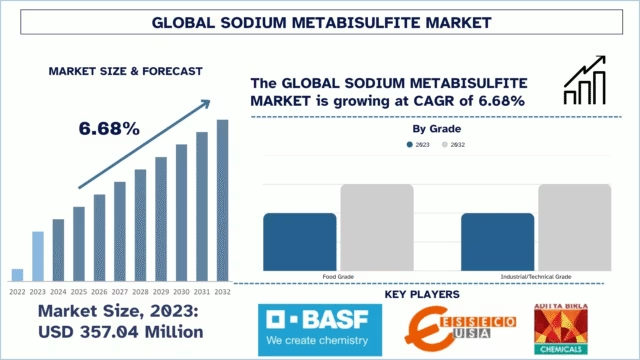According to the UnivDatos, as per their “Sodium Metabisulfite Market” report, the global market was valued at USD million in 2023, growing at a CAGR of 6.68% during the forecast period from 2024-2032 to reach USD 634.11 million by 2032.
The specialty chemicals industry has established sodium metabisulfite as a vital market segment that shows steady growth because it satisfies multiple industrial applications worldwide. The compound demonstrates essential value in worldwide water treatment and food preservation, as well as pharmaceutical manufacturing and industrial processes.
For example, China is one of the most water-scarce countries, and these water scarcity challenges seriously undermine the socioeconomic development of the nation since demand for fresh water is rising sharply. It is estimated that by 2030, water demand in China will exceed 800 billion cubic meters, thus adding pressure on the limited water resources of the country. Despite deliberate attempts to augment water availability, China continues to be faced with a water supply gap, which domestic scholars may place at up to 25 percent by 2030.
Access sample report (including graphs, charts, and figures): https://univdatos.com/reports/sodium-metabisulfite-market?popup=report-enquiry
Key Drivers of Market Growth:
Sodium metabisulfite consumption reaches approximately 40% of the total global market to treat water. The necessity for sodium metabisulfite as a dechlorination agent has increased critically because of tightening environmental standards that now affect both municipalities and industries worldwide. The updated Lead and Copper Rule by the EPA pushed U.S. water utilities to boost their treatment approaches, and the European Union established strict guidelines regarding disinfection byproducts through their revised Drinking Water Directive (2020/2184). The worldwide expansion of major urban water systems processes millions of cubic meters of water daily by utilizing sodium metabisulfite to comply with governmental regulations at institutions like London, Tokyo, and São Paulo.
Food and beverage operations stand as the sector using sodium metabisulfite at the second-highest rate, mainly through its applications in wine production and seafood processing. The worldwide wine industry depends on sodium metabisulfite as an antimicrobial agent and antioxidant to produce its 260 million hectoliter yearly output. The market growth in the Asia-Pacific demonstrates substantial increases from Chinese wine production expansion and Australian wine industry exports. The seafood processing industry of Vietnam and India has adopted more sodium metabisulfite to fulfill international food standards needed for shrimp exports directed to the United States as well as the European Union.
Technological and Regulatory Developments
Product purity and consistency have increased because manufacturers have recently made production technology innovations. The manufacturers produce pharmaceutical-grade sodium metabisulfite compliant with USP and also EP specifications by employing membrane filtration and advanced crystallization technologies. The technologies allow new manufacturing opportunities in biopharmaceutical production because the compound meets specific vaccine production requirements.
Market dynamics are constantly changing because of continuous regulatory updates. For instance, re-evaluation of processed food sulfite levels by the US FDA and the European Food Safety Authority is in the process of assessing the safety of sulfur dioxide. This has largely triggered manufacturers to make investments in R&D. Low-dust forms and enhanced packaging solutions have been introduced by some companies to boost workplace safety and product stability.
Prominent Opportunities in the Global Sodium Metabisulfite Market
Expansion in High-Purity Pharmaceutical Applications
The booming demand for high-purity pharmaceutical-grade sodium metabisulfite has made the global sodium metabisulfite market highly beneficial. This is due to the regulatory requirements and innovations in therapy formulations. Sodium metabisulfite is a very strong excipient in injectable drugs, vaccines, and oral medicines as an antioxidant and preservative to improve the stability of drug formulations. This makes it a highly lucrative opportunity for manufacturers to serve the GMP ultra-pure sodium metabisulfite need.
The shift toward biologics and mRNA-based therapies keeps setting up high gates for excipient quality. Sodium metabisulfite is used in lyophilized (freeze-dried) drug formulations and sterile injectables where even minute impurities could hamper the effectiveness. For example, sodium metabisulfite was used in buffer solutions for mRNA vaccine stabilization by Moderna and Pfizer for long-term viability during storage. Sodium metabisulfite is also found in chemotherapy drugs like paclitaxel to prevent oxidation to prevent products from aging. Regulatory pushes, such as the USP-NF and European Pharmacopoeia, have also brought forth stricter specifications for sulfur impurities. Therefore, drugmakers are required to use a higher degree of material. The growing investment by companies in low-endotoxin, high purity production (for example, BASF’s PharmaGrade® line) could, therefore, command a price at a premium (20-30% higher than industrial grade). The continuous growth, coupled with stringent excipient standards, pretty much signifies high-purity sodium metabisulfite as a billion-dollar niche market within the entire market, especially for pharmaceuticals.
Click here to view the Report Description & TOC: https://univdatos.com/reports/sodium-metabisulfite-market
Industrial Growth and Innovation Driving Sodium Metabisulfite Demand
The sodium metabisulfite market around the world is predicted to show a very steady growth due to the important applications that it has in the area of water treatment, food preservation, and pharmaceuticals. Demand for dechlorinating agents remains very strong, with more and more stringent environmental regulations and increasing water scarcity, particularly in China. Additionally, there are high-margin segments in the pharmaceutical industry, particularly for GMP-grade variants covered in vaccines and biologics. Moreover, technological advancements in purification coupled with compliance with stringent standards in USP/EP further increase the market potential. As industries concentrate on sustainability and efficacy, sodium metabisulfite will remain indispensable, and the high-purity pharmaceutical segment will turn into a billion-dollar market in the near future. Therefore, strategic investments directed toward R&D and compliant processes will position manufacturers to fully cash in on these expanding opportunities by the year 2030.
Contact Us:
UnivDatos
Contact Number – +1 978 733 0253
Email – contact@univdatos.com
Website – www.univdatos.com
Linkedin- https://www.linkedin.com/company/univ-datos-market-insight/mycompany/






